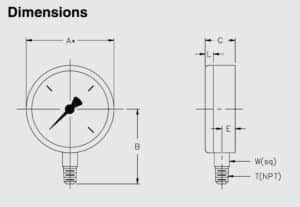Metrology Glossary: Vacuum Gauge
What Is A Vacuum Gauge?
A vacuum gauge is a specialized tool used to measure the pressure within a vacuum, characterized by a pressure level lower than that of the Earth’s atmospheric conditions. Vacuum gauges are typically classified into two primary categories: high vacuum gauges and low vacuum gauges. High vacuum gauges are engineered to measure pressures that fall below the threshold of 10^{-3} torr, providing precision in ultra-low-pressure environments. On the other hand, low vacuum gauges are designed for measuring pressures exceeding 10^{-3} torr, ensuring accurate readings for less extreme vacuum conditions. These devices serve as indispensable tools in maintaining and controlling vacuum systems across a wide range of applications.
What Are Vacuum Gauges Used For?
High Vacuum Gauges:
- Semiconductor Manufacturing: Vacuum gauges play a crucial role in overseeing and regulating pressure within semiconductor fabrication chambers. These chambers require extremely low pressures to prevent contamination and ensure the efficient operation of etching and deposition processes.
- Vacuum Furnaces: Vacuum gauges are essential for monitoring and managing pressure. Vacuum furnaces are employed to heat materials without the presence of air, preventing oxidation and other undesirable reactions.
- Analytical Chemistry: Vacuum gauges find application in various analytical chemistry instruments such as mass spectrometers and electron microscopes. They are used to measure and regulate pressure within vacuum chambers, ensuring optimal performance.
- Research and Development: In diverse research and development settings, vacuum gauges are employed for studying material properties under low-pressure conditions and developing innovative technologies for vacuum processing.
Low Vacuum Gauges:
- HVAC Systems: Vacuum gauges are employed in HVAC systems to evacuate air and other gases before charging them with refrigerant. This vacuum-pulling process helps eliminate contaminants, ensuring the efficient operation of the system.
- Vacuum Packaging: Vacuum gauges are used to monitor and adjust pressure in vacuum packaging. This packaging technique extends the shelf life of food and various products.
- Medical Equipment: Vacuum gauges play a vital role in various medical devices, including suction devices and vacuum-assisted delivery systems.
- Automotive Applications: Widely utilized in automotive settings, vacuum gauges contribute to monitoring and controlling vacuum pressure, particularly in brake systems.









